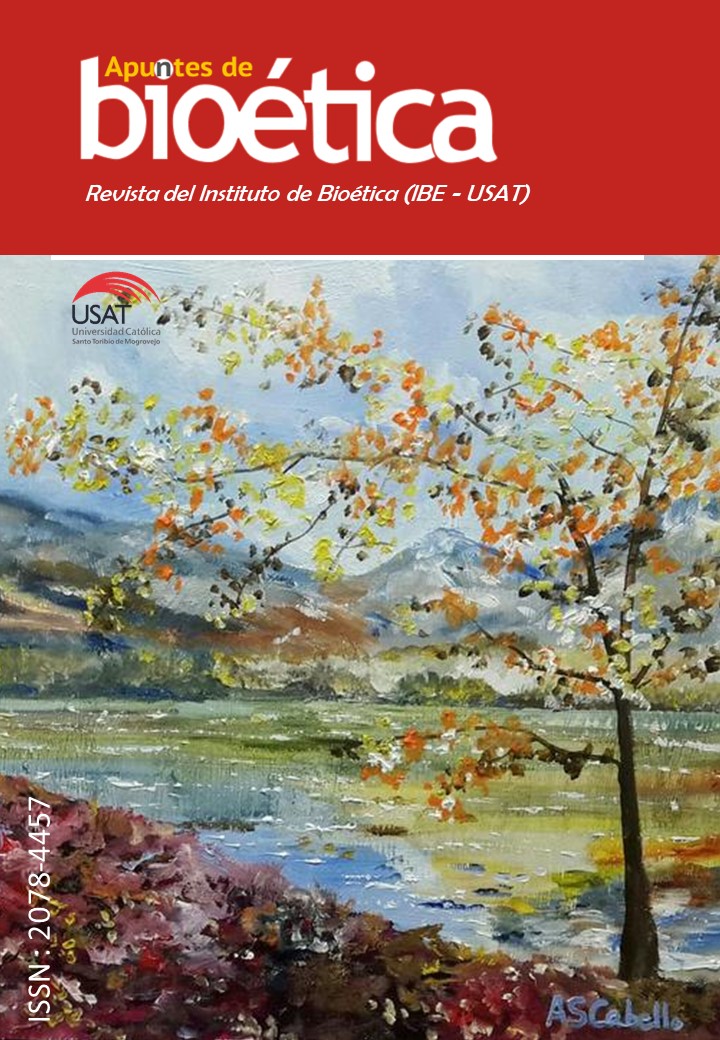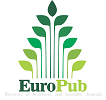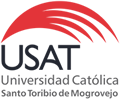Trends in the bills of laws of 2018, to regulate the techniques of artificial reproduction in Peru
Abstract
The Artificial Production Techniques (APT) generate human life in an artificial way, that is to say without observing the natural process that is the sexual union between male and female. So that, we deem it appropriate to establish bioethics and bio-legal criteria, in the circumstances that the modification of the norm about APT in Peru, will be discussed. For this purpose, with this investigation we analyze the content and consequences of the APT, we analyze the current 7th. article of the General Health Law (GHL), as well as analyze the three bills presented in the last two months to modify article 7 of the GHL; that will allow us to establish the bioethic and bio-legal criteria to regulate the APT abolishing the 7th article of the GHL. The ethic criteria are framed in the interdisciplinary of bioethic, the search for the judicial statute of the conceived and the ethic limits that should rule the science and technology.The results aim to understand that the legal order in Peru is protectionist of the conceived, but not the 7th. article of the GHL authorized by the APT, For involving risks to the life and health of human beings in the state of embryos. Our research provides bioethical and biolegal criteria to regulate the biotechnologies of the beginning of life, putting limits to the TRA, to demand it the the right of human embryos, in accordance with the biological, ontologic and legal statutes.
Downloads
References
Libros y artículos de revistas:
Agulles, P. y Guillén, M. (2011). Ética de la investigación biomédica. Trasplantes, vacunas y embriones. Valencia, España: Edicep.
Aparisi, A. (2012). Implicaciones para el derecho a la vida y a la salud de las nuevas tecnologías reproductivas. En R.G. Zurriaráin. (Ed.), La desprotección del no nacido en el siglo XXI (267-291). Madrid, España: Ediciones Internacionales Universitarias.
Ciccone, L. (2006). Bioética. Historia. Principios. Cuestiones. Madrid, España: Colección Pelícano, Ediciones Palabra.
Cozzoli, M. (1998). Lémbrione umano: aspetti etico-normativi, 237-273. En Pontificia Academia pro Vita, Identitá e statuto dell´embrione umano, Cittá del Vaticano, Vaticano: Librería Editrice Vaticana (citado en Ciccone 2006, p. 85).
Edwards, J. N., New Conceptions: Biosocial Innovations and the Family. En Journal of Marriage and the Family, 1991, mayo, 53, 2, 349-360 (citado en Ciccone 2006, p. 144).
Elbaba, J. (2007). Reproducción Artificial. En Colección AquinasNET Universidad FASTA Bioética (147-163). Mar del Plata, Argentina: Editorial Martín.
González, L. (2006). De la Bioética… al Bioderecho. Libertad, Vida y Muerte. Madrid, España: Universidad Pontificia de Comillas.
Herranz, G. (2013). El embrión ficticio. Historia de un mito biológico. Madrid, España: Ediciones Palabra.
Lacadena, J.R. (2003) Genética y bioética. Madrid, España: Editorial Desclée De Brouwer S.A.
Laferriere, J. N. (2011). Las implicaciones jurídicas del diagnóstico prenatal: El concebido como hijo y paciente. Buenos Aires, Argentina: EDUCA.
López, N. e Iraburu, M. (2006) Los quince primeros días de una vida humana. Pamplona, España: EUNSA.
Lucas, R. (1999) ¿Cuándo se inicia la persona humana? Individualidad biológica y existencia personal. En López, M. y R. Lucas (Ed.) El Inicio de la vida. Identidad y estatuto del embrión humano (59-92). Madrid, España: BAC.
Lucas, R. (2013). Explícame la bioética. Guía explicativa de los temas más controvertidos sobre la vida humana. Madrid, España: Ediciones Palabra.
Palazzani, L. I significati del concetto filosófico di persona e implicazioni nel dibattito bioético e biogiuridico attuale sullo statuto dell´embrione umano. In Pontificia Academia pro Vita (o. c.), p. 73 y ss (citado en Ciccone, 2006, p. 84).
Pardo, J. M. (2011). El no nacido como paciente. Pamplona, España: EUNSA,
Pessina, A. Bioetica. L'uomo sperimentale (citado en Sgreccia, 2009, p.146).
Sambrizzi, E. A. (2001). La procreación asistida y la manipulación del embrión humano. Buenos Aires, Argentina: Abeledo-Perrot.
Sánchez, P. (2012). Carencias de la comunicación biológica en las técnicas de reproducción asistida (TRA). En R. G. Zurriaráin. (Ed.). La desprotección del no nacido en el siglo XXI (83-88), Madrid, España: Ediciones Internacionales Universitarias.
Sgreccia, E. (2009). Manual de Bioética, Tomo I. Madrid, España: B.A.C.
Tomás, G. M. (2011). Cuestiones actuales de bioética. Pamplona, España: EUNSA.
Zurriaráin, R. G. (2007). Los embriones humanos congelados. Un desafío para la bioética. Madrid, España: Ediciones Internacionales Universitarias.
Tesis:
Cárdenas, A. (2014). El derecho de las personas concebidas mediante técnicas de reproducción asistida a conocer su identidad biológica desde una perspectiva biojurídica (tesis de maestría), Universidad Católica Santo Toribio de Mogrovejo, Chiclayo, Perú.
Gonzáles, R. P. (2013). Límites biojurídicos de la libertad de investigación respecto a la manipulación genética en la vida prenatal (Tesis de pregrado). Universidad Católica Santo Toribio de Mogrovejo, Chiclayo, Perú.
Ibañez, N. (2014) Reflexiones en torno a la jurisprudencia peruana respecto a las técnicas de reproducción asistida (tesis de pregrado), Universidad Católica Santo Toribio de Mogrovejo, Chiclayo, Perú.
Politi, M. B. (2010). Protección jurídica del concebido en el derecho peruano ante la regulación de las técnicas de reproducción asistida (Tesis de pregrado). Universidad Católica Santo Toribio de Mogrovejo, Chiclayo, Perú.
Helfer, O.M. y Tapia, S. C. B. (2016) Incorporación de criterios bioéticos y biojurídicos, ante la probable modificación de la norma sobre técnicas de reproducción artificial (Tesis de maestría). Universidad Católica Santo Toribio de Mogrovejo, Chiclayo, Perú.
Legislación:
Código Civil.
Constitución Política del Perú.
Convención Americana sobre Derechos Humanos.
Unesco (2005). Declaración Universal sobre Bioética y Derechos Humanos.
Ley N° 26842, Ley General de Salud (20 de julio de 1997), Diario Oficial El Peruano, Normas Legales 151245-151252 Recuperado de http://www4.congreso.gob.pe/ntley/Imagenes/Leyes/26842.pdf
Resolución Ministerial N° 486-2014/MINSA, del Aprueban la Guía Técnica Nacional para la estandarización del procedimiento de Atención Integral de la gestante en la Interrupción Voluntaria por Indicación Terapéutica del Embarazo menor de 22 semanas con consentimiento informado en el marco de lo dispuesto en el artículo 119 del Código Penal. [Ubicado el 22.VII2016]. Obtenido en file:///C:/Users/Sergio/Downloads/NL20140628.pdf
Linkografía:
Aparisi, A. (2013, febrero) El principio de la dignidad humana como fundamento de un bioderecho global. Cuadernos de Bioética XXIV Recuperado de: http://www.aebioetica.org/revistas/2013/24/81/201.pdf
Corte Interamericana de Derechos Humanos (2012). Caso Artavia Murillo y otros (Fertilización in vitro) Vs. Costa Rica. Recuperado de http://www.corteidh.or.cr/docs/casos/articulos/seriec_257_esp.pdf
Miralles, A. (1980). Naturaleza y Sacramento en la doctrina del Concilio Vaticano II sobre el matrimonio. En Cuestiones fundamentales sobre matrimonio y familia, Pamplona, España, EUNSA, (149-168). Recuperado de http://www.collationes.org/de-vita-christiana/matrimonio-et-familia/item/1817-naturaleza-y-sacramento-en-la-doctrina-del-concilio-vaticano-ii-sobre-el-matrimonio.
Nascentis Especialistas en Fertilidad. La Fertilización InVitro. Córdoba, Argentina. Nascentis. Recuperado de http://www.nascentis.com/cmo_es_un_tratamiento_de_fertilizacin_in_vitro_con_donacin_de_vulos.
Pardo, A. (2003). La fecundación in vitro. Recuperado de http://www.unav.es/cdb/dhbapfivet.html
Proyecto de ley N° 3313/2018-CR, ingresado al Congreso de la República el 7 de setiembre de 2018. Recuperado de: http://www.congreso.gob.pe/pley-2016-2021
Proyecto de ley N° 03404/2018-CR, ingresado al Congreso de la República el 18 de setiembre de 2018. Recuperado de: http://www.congreso.gob.pe/pley-2016-2021
Proyecto de ley N° 03542/2018-CR, ingresado al Congreso de la República el 11 de octubre del 2018. Recuperado de: http://www.congreso.gob.pe/pley-2016-2021
The authors retain copyright.
This work is under international license Creative Commons Attribution 4.0.
The articles published by the scientific journal "Notes on Bioethics" of the Universidad Catolica Santo Toribio de Mogrovejo, Chiclayo Peru, can be shared through the international public license Creative Commons Attribution CC BY 4.0
























 LIBRARY USAT
LIBRARY USAT